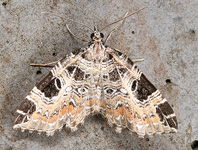Abstract
Two new species of Luciobarbus are described from the Mediterranean Sea basin in Morocco and Algeria. Their monophyly and phylogenetic placement are resolved by molecular analyses using two mitochondrial markers (cyt b and D-loop). Luciobarbus lanigarensis, new species, from the Tafna River drainage in Algeria and Morocco, is distinguished by having orange fins, a great predorsal length (52–59% SL) and a very long pectoral fin (79–90% HL). Luciobarbus numidiensis, new species, from the El-Kébir River drainage in Algeria, is distinguished by having a golden pectoral-fin margin, 43–47+1–3 lateral line scales and a very long anal-fin (19–23%).
References
Bazinet, A.L., Zwikhl, D.J. & Cummings, M.P. (2014) Agateway for phylogenetic analysis powered by grid computing featuring GARLI 2.0. Systematic Biology, 63, 812–818.
https://doi.org/10.1093/sysbio/syu031Brahimi, A., Freyhof, J., Henrard, A. & Libois, R. (2017) Luciobarbus mascarensis and Luciobarbus chelifensis (Cyprinidae): two new species in Algeria. Zootaxa, 4277 (1), 32–50.
https://doi.org/10.11646/zootaxa.4277.1.3Casal-Lopez, M., Perea, S., Yahyaoui, A. & Doadrio, I. (2015) Taxonomic review of the genus Luciobarbus Heckel; 1843 (Actinopterygii, Cyprinidae) from northwestern Morocco with the description of three new species. Graellsia, 71, 1–24
https://doi.org/10.3989/graellsia.2015.v71.135Clavero, M., Qninba, A., Riesco, M., Esquivias, J., Calzada, J. & Delibes, M. (2017) Fish in Mo- roccan desert rives: the arid extreme of Mediterranean streams. Fishes in Mediterranean Environments, 003, 1–21.
https://doi.org/10.29094/FiSHMED.2017.003Doadrio, I., Casal-López, M. & Perea, S. (2016a) Taxonomic remarks on Barbus moulouyensis Pellegrin, 1924 (Actinopterygii, Cyprinidae) with the description of a new species of Luciobarbus Heckel, 1843 from Morocco. Graellsia, 72, 1–24.
https://doi.org/10.3989/graellsia.2016.v72.174Doadrio, I., Casal-López, L. Perea, S. & Yahyaoui, A. (2016b) Taxonomy of rheophilic Luciobarbus Heckel, 1842 (Actinopterygii, Cyprinidae) from Morocco with the description of two new species. Graellsia, 72, 1–17.
https://doi.org/10.3989/graellsia.2015.v71.135Felsenstein, J. (1981) Evolutionary tree from DNA sequences, a maximum likelihood approach, Journal of Molecular Evolution, 17, 368–376.
https://doi.org/10.1007/BF01734359Geiger, M.F., Herder, F., Monaghan, M.T., Almada, V., Barbieri, R., Bariche, M., Berrebi, P., Bohlen, J., Casal-Lopez, M., Delmastro, G.B. Denys, G.P., Dettai, A., Doadrio, I., Kalogianni, E., Kärst, H., Kottelat, M., Kovačić, M., Laporte, M., Lorenzoni, M., Marčić, Z., Özuluğ, M., Perdices, A., Perea, S., Persat, H., Porcelotti, S., Puzzi, C., Robalo, J., Šanda, R., Schneider, M., Šlechtová, V., Stoumboudi, M., Walter, S. & Freyhof, J. (2014) Spatial heterogeneity in the Mediterranean Biodiversity Hotspot affects barcoding accuracy of its freshwater fishes. Molecular Ecology Resources, 14, 1210–1221.
https://doi.org/10.1111/1755-0998.12257Gouy, M., Guindon, S. & Gascuel, O. (2010) SeaView Version 4: A multiplatform graphical user interface for sequence alignment and phylogenetic tree building. Molecular Biolology and Evolution, 27, 221–224.
https://doi.org/10.1093/molbev/msp259Hasegawa, M., Kishino, H. & Yano, T. (1985) Dating of the human-ape split by a molecular clock by michondrial DNA. Journal of Molecular Evolution, 22, 160–174.
https://doi.org/10.1007/BF02101694Iguchi, K., Tanimura, Y. & Nishida, M. (1997) Sequence divergence in the mtDNA control region of amphidromous and landlocked forms of ayu. Fish Sciences, 63, 901–905.
https://doi.org/10.2331/fishsci.63.901Katoh, K. & Standley, D.M. (2013) MAFFT Multiple sequence alignment Software Version 7. Improvements in performance and usability. Molecular Biology and Evolution, 30, 772–780.
https://doi.org/10.1093/molbev/mst010Kimura, M. (1980) Estimation of evolutionary distances between homologous nucleotide sequences. Proceedings of the National Academy of Sciences, 78, 454–458.
https://doi.org/10.1073/pnas.78.1.454Kottelat, M. & Freyhof, J. (2007). Handbook of European Freshwater Fishes. Cornol, Suisse, xiv + 646 pp.
Lanave, C., Preparata, G., Saccone, C. & Serio, G. (1984) A new method for calculating evolutionary substitution rates. Journal of Molecular Evolution, 20, 86–93.
https://doi.org/10.1007/BF02101990Lanfear, R., Frandsen, P.B., Wright, A.M., Senfeld, T. & Calcott, B. (2017) PartitionFinder 2: new methods for selecting partitioned models of evolution for molecular and morphological phylogenetic analyses. Molecular Biolology and Evolution, 34, 772–773.
https://doi.org/10.1093/molbev/msw260Nishida, M., Ohkawa, T. & Iwata, H. (1998) Methods of analysis of genetic population structure with mitochondrial DNA markers. Fish Genetics and Breeding Science, 26, 81–100.
https://doi.org/10.1371/journal.pone.0179706Palumbi, S.R. (1996) Nucleic acids II: The polymerase chain reaction. In: Hillis, D.M., Moritz, C. & Mable, B.K. (Eds.), Molecular Systematic. 2nd Edition. Sinauer, Sunderland, MA, pp. 5–247.
Perdices, A. & Doadrio, I. (2001) The molecular systematics and biogeography of the European cobitids based on mitochondrial DNA sequences. Molecular Phylogenetics and Evolution, 19, 468–478.
https://doi.org/10.1006/mpev.2000.0900Rambaut, A. (2009) FigTree. Version 1.4.2. Available from: http://tree.bio.ed.ac.uk/software/figtree/ (accessed 2 May 2017)
Rodríguez, F., Oliver, J.L., Marín, A. & Medina, J.R. (1990) The general stochastic model of nucleotide substitution. Journal of Theoretical Biology, 142 (4), 485–501.
https://doi.org/10.1016/S0022-5193(05)80104-3Ronquist. F., Teslenko, M., Mark, P., Ayres, D.L., Darling, A., Höhna, S., Larget, B., Liu, L., Suchard, M.A. & Huelsenbeck, J.P. (2012) MrBayes 3.2. Efficient Bayesian phylogenetic inference and model choice across a large, model space. Systematic Biology, 61, 539–542.
https://doi.org/10.1093/sysbio/sys029Sukumaran, J. & Holder, M.T. (2010) DendroPy, a Python library for phylogenetic computing. Bioinformatics, 26, 1569–1571.
https://doi.org/10.1093/bioinformatics/btq228Sukumaran, J. & Holder, M.T. (2015) SumTrees. Phylogenetic tree Summarization, 4.0.0 Available from: https://github.com/ jeetsukumaran/Dendrophy (accessed 2 May 2017)
Talavera, G. & Castresana, J. (2007) Improvement of phylogenies after removing divergent and ambiguously aligned blocks from protein sequence alignments. Systematic Biology, 56, 564–577.
https://doi.org/10.1080/10635150701472164Tamura, K., Stecher, G., Peterson, D., Filipski, A. & Kumar, S. (2013) Molecular Evolutionary Genetics Analysis: MEGA version 6.0. Molecular Biology and Evolution 30, 2725–2729.
https://doi.org/10.1093/molbev/mst197Tavaré, S. (1986) Some probabilistic and statistical problems in the analysis of DNA sequences. Lectures on Mathematics in the Life Sciences (American Mathematical Society), 17, 5786.

